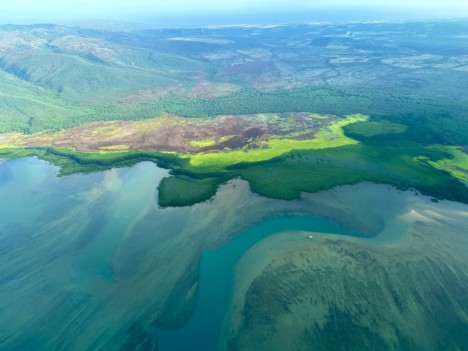Researchers Study Potential Toxins in Reef from Lahaina Fires
The August wildfires which ravaged areas of Maui have cast a looming shadow over the marine life and fish populations, particularly in the waters adjacent to Lahaina — including those off Molokai. The aftermath of the deadliest U.S. wildfire in a century has left behind a toxic legacy, with concerns mounting over the potential contamination of the ocean waters, according to reports from the Dept. of Land and Natural Resources and the Nature Conservancy.
A primary concern regarding the contamination of marine ecosystems is the impacts to neighboring islands, such as Molokai. Scientists believe that the ocean currents may have transported contaminants from Lahaina waters to Molokai, which can potentially affect fish populations and coral reefs.
Eric Conklin, the Nature Conservancy’s director of marine science for Hawaii and Palmyra, underscored the interconnectedness of Lahaina and Molokai’s ecosystems, emphasizing that fish caught off the reefs of Molokai could bear compounds originating from the wildfires in Lahaina.
“Fish that you collect to eat off of a reef on Molokai may very well have compounds that washed into the water from rainfall in Lahaina and got transported to ocean currents across the channel and onto the reefs of neighboring islands,” said Conklin in an interview with the Associated Press.
A potential concern for the community is the consumption of large apex predators, like ulua, ‘ahi, aku, ono, and mahimahi. These higher-level predator-fish build up greater and more dangerous amounts of toxic materials like mercury, lead, and sulfate, than animals lower on the food chain due to biomagnifications. However, the commonly caught inland fish on Molokai, such as kole, manini, palani, ‘ama’ama, nenue, and ‘u’u, which are lower on the food chain, have the highest risk of contamination from micro-plastic debris.
Since this was the first significant urban fire to have occurred adjacent to a coral reef nationwide, researchers are using the Maui fires to investigate the potential impacts of chemicals and metals from burned plastics, lead paint, and lithium-ion batteries on vulnerable reef ecosystems.
The University of Hawaii at Manoa researchers and citizen science groups currently have sensors to track water quality parameters and are collecting tissue samples from marine life to analyze for signs of heavy metals and pollutants, to understand the full extent of the wildfire’s impact on marine ecosystems. There has not been enough data collected yet to draw conclusions, however researchers are hoping to release results within a month.
Efforts to mitigate harmful runoff are underway, with authorities implementing measures to prevent further contamination, but the long-term effects of the Lahaina fires remain uncertain. Andrea Kealoha, leading the University of Hawaii research project, anticipated that signs of contamination may emerge over the coming years, highlighting the need for sustained monitoring efforts supported by state funding on both Maui and Molokai.












Don't have a Molokai Dispatch ID?
Sign up is easy. Sign up now
You must login to post a comment.
Lost Password